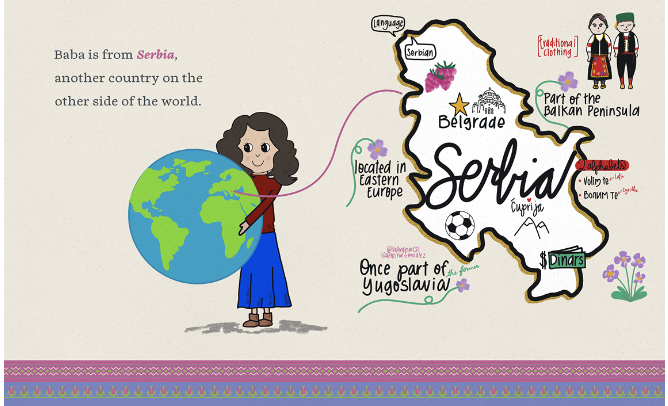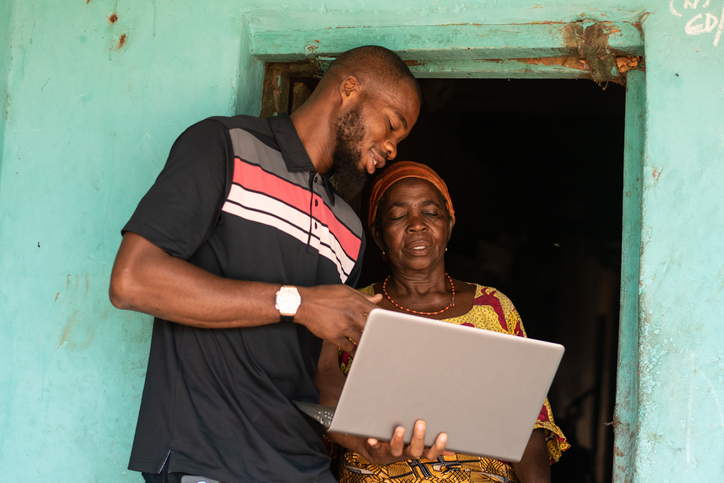

Even behind masks or through a screen, the language that educators use is one of the most powerful tools available to build a relationship with students, support their identities, and scaffold their learning.
Like our breath, our teacher language is always with us and has a significant effect on how we self-regulate and exchange energy with our classes. That might sound lofty or ethereal, but it’s fundamentally true. Most of us rarely think about our breath, but science and experience tell us that when we control our breath, we can better manage our emotions, health, and relationships (Walter et al., 2020). Similarly, the spoken and nonverbal language we choose to use in our classrooms and with our school communities can guide our connections with others. Being aware of our language is the first step in making sure the words we use have the outcomes we intend.
Teacher Language Is a Powerful Tool
Consider your own educational experience. Do you recall something a teacher said to you? Was it positive or negative? Many of us recall things said to us from long ago—or even recently—and those recollections are often accompanied by emotions.
In her book The Power of Our Words, Paula Denton explains how the language used in any learning environment can impact a student:
Language is one of the most powerful tools available to teachers. It permeates every aspect of teaching and learning. We cannot engage children in learning, welcome a child into the room, or handle a classroom conflict without using words. Children cannot do a science observation or reading assignment or learn a classroom routine without listening to and interpreting their teacher’s words. And what they hear and interpret—the message they get from their teacher—has a huge impact on how they think and act, and ultimately how they learn. (2016, p. 1)
Because language, both verbal and nonverbal, can be so influential, we need to consider our intentions, choices, and delivery. Our language can shape students’ learning, identity, and behaviors in the moment and over time. All humans have a need to feel a sense of belonging and significance. When we use specific language that tells a child we see them and we value them, it lays the foundation for the sense both of belonging and of significance. When our language is encouraging, respectful, and genuine, and when we combine that with patience and trust, the message to students is that they matter. When we add specific feedback to our language repertoire, we help students see their strengths and learn from mistakes, rather than seek our approval or fear criticism. Ultimately, this language can lead to growth and healthy development. Effective teacher language is a model of firm faithfulness that encourages and promotes students’ best efforts and growth.
Characteristics of Positive Teacher Language
Positive teacher language has five main characteristics that may sound deceptively simple. These characteristics are aspirational; with practice, they become habits of our engagement with students and colleagues, but they take time and sustained effort to develop. These traits can serve as guidelines as you consider what to say and how to say it.
Be direct and genuine. One way we can be direct and genuine is to ensure that our body language—gestures, postures, and facial expressions—matches our words. When a teacher’s words are not true to their intentions, their body language is likely to give them away. For example, a teacher saying “Let’s all calm down!” in a loud, high-pitched voice while wringing her hands does not convey a sense of calm.
Another way educators can be direct and genuine is to use statements, not questions. Teachers often try to soften commands or directions by phrasing them as questions in the hopes of making them seem more respectful. It’s disingenuous for me to ask my twelve-year-old son “Can you take out the trash?,” as it leads him to believe he has a choice. I can be clearer and more honest by saying simply and directly, “James, take out the trash.”
Convey faith. This is perhaps the most accessible and impactful way to use positive language. When a teacher notices the positives and comments on the things students do, they convey faith in the students’ abilities. For example: “You’re trying lots of different strategies for solving that problem. That takes persistence,” or “You finished cleaning up in less than five minutes today!”
Our language can be a buffer to the self-doubt and fear of risk or failure many students carry. Our verbal and nonverbal language can help them see and hear that our faith is greater than their doubt. Small gains and steps can be readily acknowledged and celebrated and lead to bigger gains down the road.
Focus on action. One way to do this with teacher language is to connect abstract terms to concrete actions that stress the deed, not the doer. Focusing on action is a place to be specific and provides explicit feedback to students. Rather than saying “Be respectful,” try a statement focused on action: “When you talk with your partner, make sure each of you has time to share your ideas.”
Keep it brief. It’s difficult for students to follow long strings of words. Students understand more when adults speak less. For some of us, this is a tricky pattern to unwind and change! One way to keep it brief is to leave out warnings. It can be tempting to warn students what will happen if they don’t heed reminders and directions. For example, “If this kind of playing around continues, we may have to use recess time to review and practice the rules.” Such warnings often come across as threats. Threats tell students that teachers think they are unlikely to behave well. Threats emphasize that teachers have the power to get children in trouble rather than students having the power to take care of themselves. Threats make the fixing of mistakes feel like a punishment and something to avoid rather than a positive way to learn and grow.
Know when to be silent. Skillful use of silence is as meaningful as the use of language itself. Silence allows for thinking time and for students’ voices to be heard. One way teachers use silence is to provide wait time. Pause before responding to a question or before taking a student’s responses. By pausing for even just three to five seconds before calling on students, teachers can raise the quality of classroom conversation. Silence is hard for many of us to sit with, but incorporating micropauses allows everyone time to think and process. It also gives students a way to practice patience and holding space for others to think and respond.
Types of Teacher Language
The skillful use of teacher language has the power to help create and maintain a positive, encouraging, and respectful classroom community. Educators spend most of their days talking and listening to students, so focusing on using positive language can have a significant impact. Every use of teacher language in the classroom can be categorized into one of the four main types of teacher language. Understanding these types of language is the first step to using this tool with skill and accuracy.
Reinforcing language helps students understand that success is about hard work, persistence, and a positive attitude. We can help students focus on their strengths by moving beyond general praise (“Great job”) and instead naming concrete and specific actions that illustrate what students are doing well (“I see you’re checking your work before turning it in”). This allows students to know exactly when they are on the right track and what actions and behaviors are contributing to that (Vincent, 2021).
Reminding language prompts students to remember expectations they’ve learned and to make positive decisions based on those expectations. In addition, reminding language can help students get back on track if they’ve strayed off course. To use reminding language effectively, keep reminders brief and use neutral wording and tone. Consider asking questions that prompt students to think and respond, like “What will you do if you get stuck during our independent work period?” Reminding language is especially effective when used to frontload expectations, so consider using it before an activity, transition, or work period begins (Vincent, 2021; Denton, 2013).
To set a positive tone for future work and engage children in problem solving, use envisioning language. This type of positive language is ideal for conversations around setting goals and solving problems as well as launching new units of study. Envisioning language can be used to motivate and encourage. It is most effective when it connects the matter at hand (a new assignment, a problem at recess, etc.) to something that the students care deeply about in their larger lives and when it gives students the opportunity to fill in the details (Denton, 2013). For instance, you might use envisioning language to help the classroom brainstorm rules or guidelines: “We need to be careful listeners to do our best learning. What do careful listeners do?”
It would be wonderful if we could spend all of our time using reinforcing, reminding, and envisioning language, but every educator knows there are moments when we need to give clear, firm instructions. That’s where redirecting language comes in. Skillful use of redirecting language guides students to stay on track and reassures them that they are safe and supported. To use redirecting language effectively, be direct, specific, and brief. Name the desired behavior calmly and firmly. For instance, replace “Why aren’t you lined up yet?” with a clear redirecting statement like “Line up and face forward.”
Shifting Your Teacher Language
Language is deeply ingrained in our upbringing and lived experiences. It is learned through what we hear, receive, and attend to, and our language patterns develop in ways we are not even aware of. If you are ready to begin making positive changes in your teacher language, consider these subtle yet significant shifts (Gheen, 2021):
Instead of “I like,” try “I notice.” When we start with “I notice,” we are naming specific behaviors students are doing well, rather than imposing our own judgment or pleasure about student behavior or performance. Recognize the specific efforts that led to success: “I noticed you worked for ten minutes without stopping, and you’ve completed your math assignment!”
Use inclusive language. By using inclusive language such as “second graders,” “students,” “math-thinkers,” or “artists,” we are sending the message that everyone belongs. It also builds confidence and self-esteem as we see students as learners across domains and we have faith in their abilities.
Practice nonjudgmental questions. When we convey our faith in students, it builds confidence and skills, which often lead to a deeper engagement and willingness to cooperate. If students feel intimidated or unvalued, they engage more in negative attention-seeking or misbehavior. Open-ended questions such as “What’s your plan for writing?” let students solve their problems with autonomy while leaving room for them to ask questions and accept help.
Practice calm firmness. A neutral tone helps everyone maintain balance, but it is often hard for us if we are feeling frazzled or stressed. When we can use a neutral, respectful, judgment-free tone, we not only foster a positive learning environment and convey trust but also keep our own emotions in check. Taking a deep breath or practicing silence allows us to intentionally use a calm tone of voice and maintains the dignity of students.
Changing our teacher language takes time. The first step is becoming more aware of our patterns, followed by making incremental changes that will last. If you’re ready to make positive changes in your teacher language, consider recording yourself or asking a trusted partner to listen in and provide feedback. Set a goal to add a few phrases to your daily conversations that focus on seeing the positives and conveying your faith in students. Our language is one of our most powerful teaching tools, so the time and effort you put into these positive practices will have a significant impact for your students and their learning.
References:
Denton, P. (2013). The Power of Our Words: Teacher Language That Helps Children Learn. Center for Responsive Schools, Inc.
Gheen, M. (2021). “Shifting Teacher Language to Communicate Effectively and Respectfully.” Journal of Social and Emotional Learning, 3(3), 12–15.
Vincent, K. (2021). Make Learning Meaningful: How to Leverage the Brain’s Natural Learning Cycle in K–8 Classrooms. Center for Responsive Schools, Inc.
Walter, H., Kausch, A., Dorfschmidt, L., Waller, L., Chinichian, N., Veer, I., … and Kruschwitz, J. D. (2020). “Self-control and Interoception: Linking the neural substrates of craving regulation and the prediction of aversive interoceptive states induced by inspiratory breathing restriction.” Neuroimage, 215, 116841.
Lisa Dewey Wells has taught nearly every elementary grade over her almost 30-year teaching career and is currently a consulting teacher for Center for Responsive Schools and a parenting/education coach. She is the co-author of Empowering Educators: A Comprehensive Guide to Teaching Grades K, 1, 2 and a forthcoming book on parenting language, both from Center for Responsive Schools.













